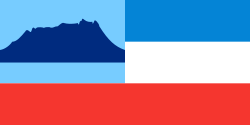 | |
| Use | Civil and state flag |
|---|---|
| Proportion | 1:2 |
| Adopted | 16 September 1988 |
| Design | Red, white and three different shades of blue |
| Designed by | Yaman Ahmad Mus |
The flag of Sabah, a state of Malaysia, was adopted on 16 September 1988, the 25th anniversary of the formation of the Malaysian Federation. It is red, white and three different shades of blue. The mountain is in the canton as in the 1963 flag, but now in dark blue on a light blue background. The field is medium blue over white over red. The mountain shown on the flag (and the state's coat of arms) is Mount Kinabalu. [1] [2]
Contents
- Symbolism
- First Sabah state flag (1963–1981)
- Second Sabah state flag (1982–1988)
- Historical flags
- City flags
- See also
- References
- External links
The five different colours represent the five divisions in Sabah. [3]
- A silhouette of Mount Kinabalu represents the state of Sabah.
- Zircon blue represents peace and calmness.
- Icicle blue represents unity and prosperity.
- Royal blue represents strength and harmony.
- White represents purity and justice.
- Chilli red represents courage and determination.













